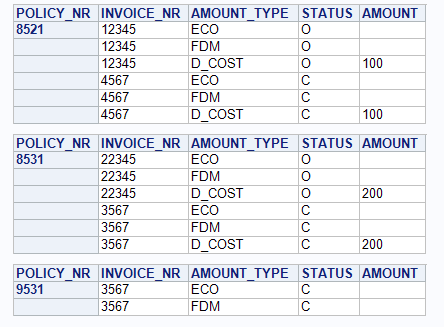- Home
- /
- Programming
- /
- SAS Procedures
- /
- Combining two data sets in a specific way
- RSS Feed
- Mark Topic as New
- Mark Topic as Read
- Float this Topic for Current User
- Bookmark
- Subscribe
- Mute
- Printer Friendly Page
- Mark as New
- Bookmark
- Subscribe
- Mute
- RSS Feed
- Permalink
- Report Inappropriate Content
I need to combine two data sets in a specific way, and could use some advice.
Input #1:
| POLICY_NR | INVOICE_NR | AMOUNT_TYPE | STATUS |
|---|---|---|---|
| 8521 | 12345 | ECO | O |
| 8521 | 12345 | FDM | O |
| 8521 | 4567 | ECO | C |
| 8521 | 4567 | FDM | C |
Input #2:
| POLICY_NR | AMOUNT_TYPE | AMOUNT |
|---|---|---|
| 8521 | D_COST | 100 |
Desired output:
| POLICY_NR | INVOICE_NR | AMOUNT_TYPE | AMOUNT | STATUS |
|---|---|---|---|---|
| 8521 | 12345 | ECO | O | |
| 8521 | 12345 | FDM | O | |
| 8521 | 12345 | D_COST | 100 | O |
| 8521 | 4567 | ECO | C | |
| 8521 | 4567 | FDM | C | |
| 8521 | 4567 | D_COST | 100 | C |
Everything has the same POLICY_NR. Input #2 needs to be appended into Input #1 two times: once for each INVOICE_NR. When it's appended, the respective INVOICE_NR and STATUS need to be filled out for each of the two rows with AMOUNT_TYPE=D_COST.
Thanks for any suggestions you might give me in regards to this.
Accepted Solutions
- Mark as New
- Bookmark
- Subscribe
- Mute
- RSS Feed
- Permalink
- Report Inappropriate Content
I think using a KEYed SET would work nicely.
input (POLICY_NR INVOICE_NR AMOUNT_TYPE STATUS)($);
cards;
8521 12345 ECO O
8521 12345 FDM O
8521 4567 ECO C
8521 4567 FDM C
8531 22345 ECO O
8531 22345 FDM O
8531 3567 ECO C
8531 3567 FDM C
9531 3567 ECO C
9531 3567 FDM C
;;;;
run;
data two(index=(policy_nr));
input (POLICY_NR AMOUNT_TYPE AMOUNT)($);
cards;
8521 D_COST 100
8531 D_COST 200
;;;;
run;
data three;
set one;
by policy_nr invoice_nr;
output;
if last.invoice_nr then do;
set two key=policy_nr/unique;
if _iorc_ eq 0 then output;
else _error_=0;
end;
call missing(amount);
run;
proc print;
by policy_nr;
id policy_nr;
run;

- Mark as New
- Bookmark
- Subscribe
- Mute
- RSS Feed
- Permalink
- Report Inappropriate Content
Hello,
One solution:
data master;
input POLICY_NR INVOICE_NR AMOUNT_TYPE $ STATUS $;
datalines;
8521 12345 ECO O
8521 12345 FDM O
8521 4567 ECO C
8521 4567 FDM C
8522 4567 FDM C
8523 4567 FDM C
;
data updatee;
input POLICY_NR AMOUNT_TYPE $ AMOUNT ;
datalines;
8521 D_COST 100
8522 D_COST 100
;
proc sort data=master;
by POLICY_NR INVOICE_NR;
run;
data want;
set master;
length amount 8;
if _n_=1 then do;
call missing(amount);
declare hash u(dataset:"updatee");
u.definekey('POLICY_NR');
u.definedata('AMOUNT_TYPE','AMOUNT');
u.definedone();
end;
by POLICY_NR INVOICE_NR;
if last.INVOICE_NR then do;
output;
if u.find() eq 0 then output;
end;
else output;
run;
- Mark as New
- Bookmark
- Subscribe
- Mute
- RSS Feed
- Permalink
- Report Inappropriate Content
As an alternative, use conditional output statements on a merged dataset (using Loko's test data):
data want;
merge master updatee (rename=(amount_type=amountt amount=amt));
by policy_nr;
run;
proc sort data=want;
by policy_nr invoice_nr;
run;
data want2 (drop=amountt amt);
set want;
by policy_nr invoice_nr;
length amount $10;
if last.invoice_nr then do;
output;
amount_type=amountt;
amount=amt;
output;
end;
else output;
run;
- Mark as New
- Bookmark
- Subscribe
- Mute
- RSS Feed
- Permalink
- Report Inappropriate Content
I think using a KEYed SET would work nicely.
input (POLICY_NR INVOICE_NR AMOUNT_TYPE STATUS)($);
cards;
8521 12345 ECO O
8521 12345 FDM O
8521 4567 ECO C
8521 4567 FDM C
8531 22345 ECO O
8531 22345 FDM O
8531 3567 ECO C
8531 3567 FDM C
9531 3567 ECO C
9531 3567 FDM C
;;;;
run;
data two(index=(policy_nr));
input (POLICY_NR AMOUNT_TYPE AMOUNT)($);
cards;
8521 D_COST 100
8531 D_COST 200
;;;;
run;
data three;
set one;
by policy_nr invoice_nr;
output;
if last.invoice_nr then do;
set two key=policy_nr/unique;
if _iorc_ eq 0 then output;
else _error_=0;
end;
call missing(amount);
run;
proc print;
by policy_nr;
id policy_nr;
run;

Learn the difference between classical and Bayesian statistical approaches and see a few PROC examples to perform Bayesian analysis in this video.
Find more tutorials on the SAS Users YouTube channel.
SAS Training: Just a Click Away
Ready to level-up your skills? Choose your own adventure.



